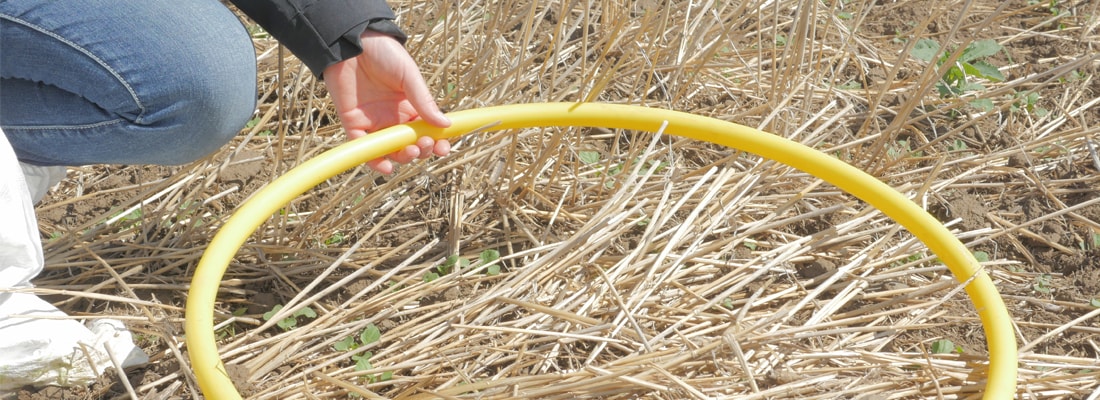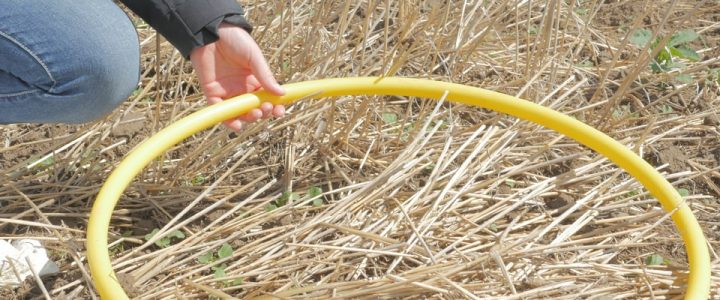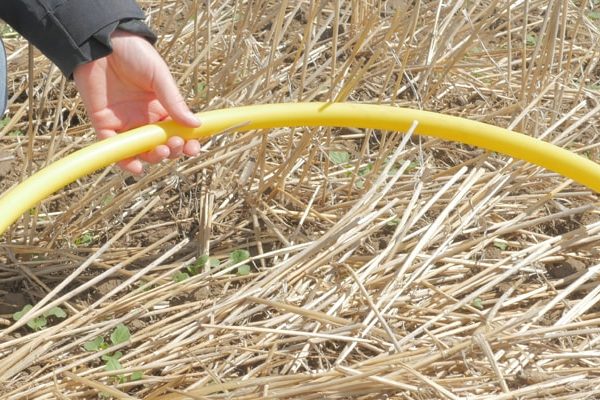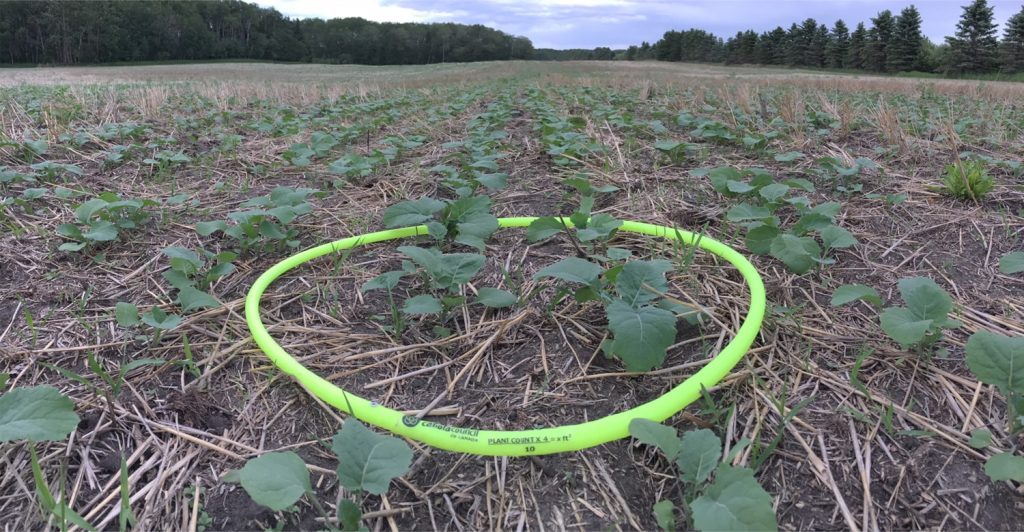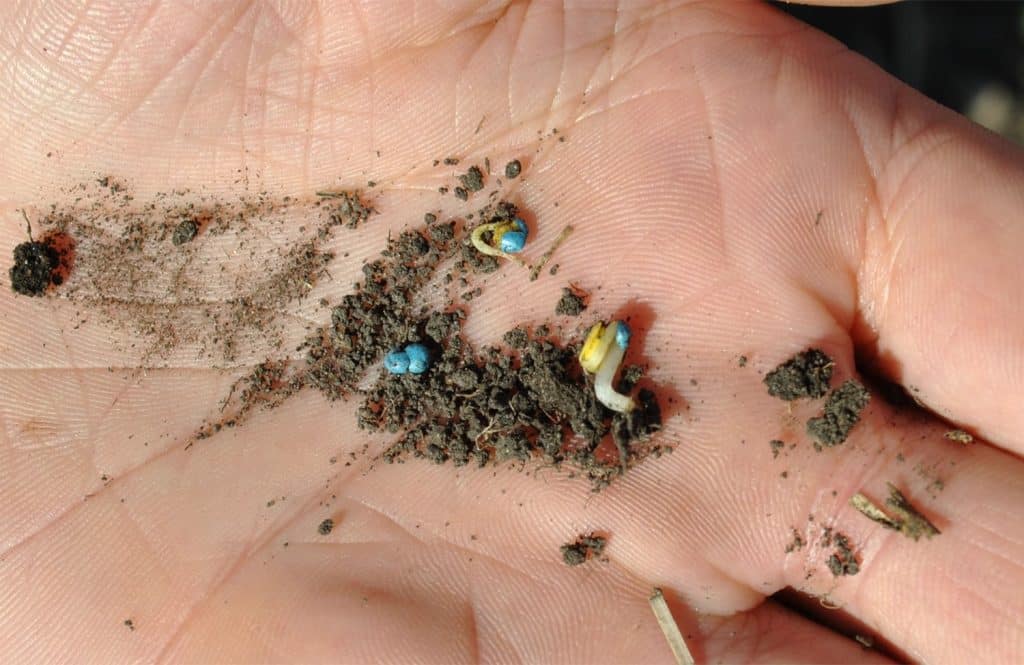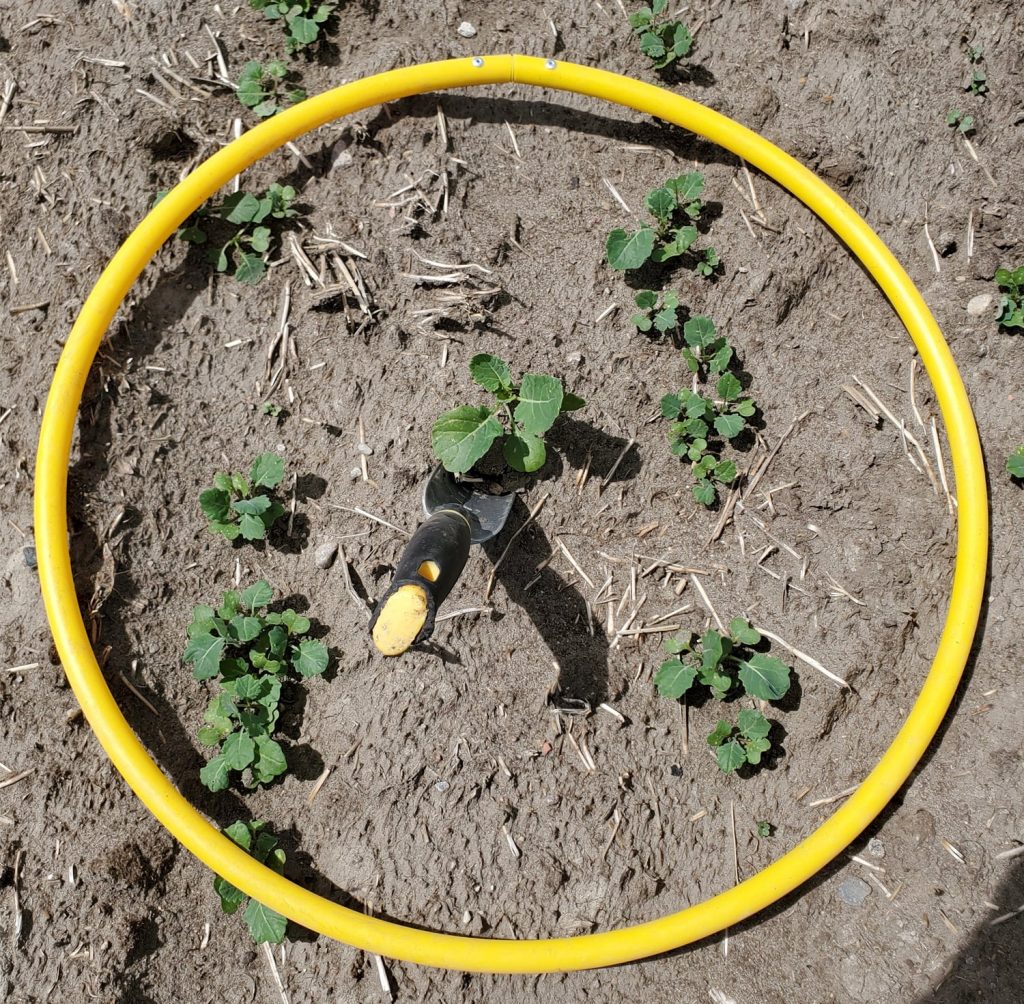Assessing canola from the two- to four-leaf stages (and again after harvest to better understand any in-season plant mortality) will help growers understand their optimum plant densities and identify areas for improvement in canola stand establishment. This can help with reseeding decisions and seeding rate assessment, and in future decisions about pest threats and whether thresholds should be lowered if plant stands are at critical low levels.
Important tips for canola plant stands
In preparation for seeding and when evaluating the stand, use these tips and tools:
- Prior to seeding, set a target plant density that fits with your individual field conditions, abilities and appetite for risk with the Target Plant Density Calculator.
- With a target plant density, you can calculate your optimum canola seeding rates and seed cost or using the Seeding Rate Calculator.
- Note that plant densities below 30-40 plants per m2 (three to four plants per square foot) are unlikely to achieve their full yield potential but may still outperform canola that is re-seeded late in the season.
- Once canola is growing, you can calculate emergence percentageThe average number (percentage) of seedlings that have grown out of the number of seeds planted this spring. More from in-field plant counts using the Plant Emergence Calculator.
- Enter your plant densities and see how they compare to others with Canola Counts, the crowd-sourced survey.
- Count seedlings growing in seed rows, dig to find non-germinated or non-emerged seeds and return frequently to assess density and emergence.
Taking count
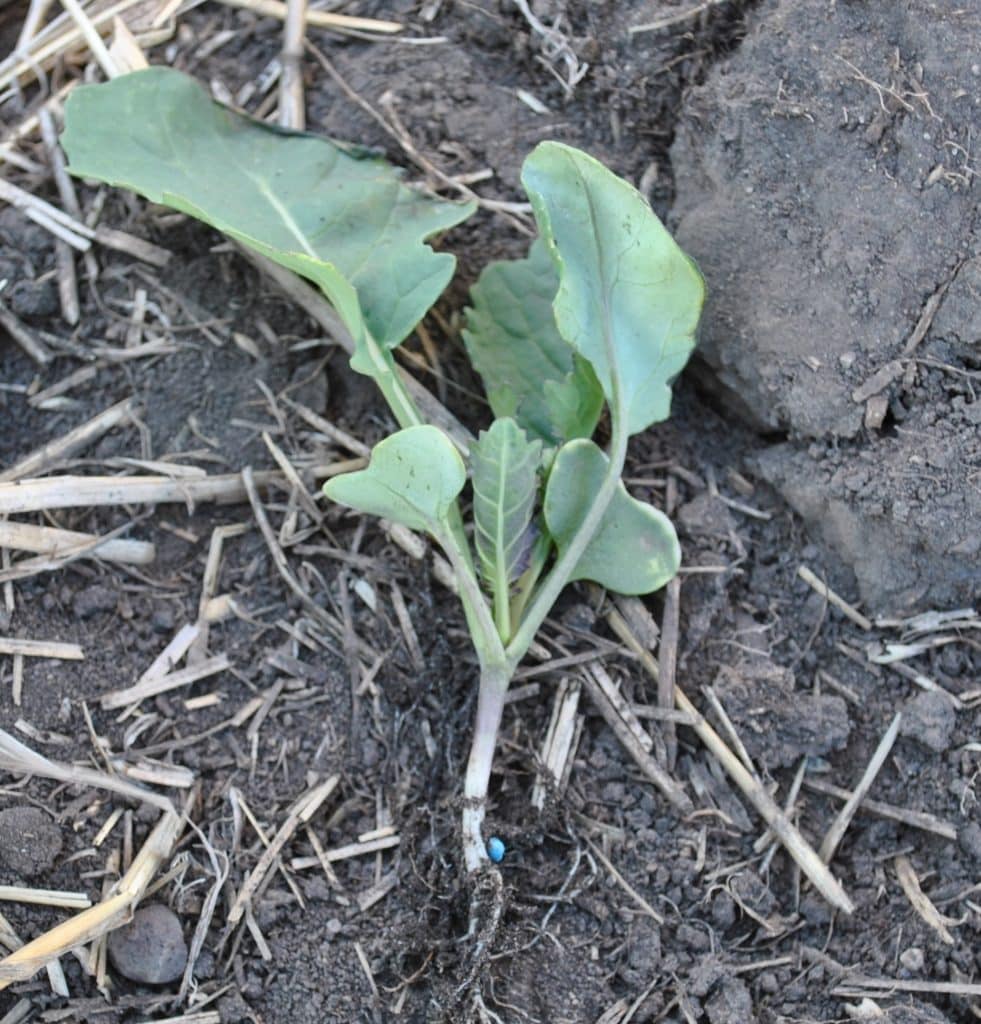
Plant counts help quantify the success of canola stand establishment in a given field. Multiple counts averaged across a field will give an average plant density for that field, which can then be compared to target plant density and emergence percentageThe average number (percentage) of seedlings that have grown out of the number of seeds planted this spring. More. Understanding each field’s plant density and emergence percentageThe average number (percentage) of seedlings that have grown out of the number of seeds planted this spring. More will help with management decisions in that field, that season, and will identify areas for improvements for future seasons. Enter the plant counts from your canola field in Canola Counts, the crowd-sourced survey.
To take plant counts with a hoop (watch video above):
- Using metric (plants per square metre) measurements: use a hoop with an area of one quarter of a square metre (0.25 m2), which will have an inside diameter of 56 centimetres and a circumference of 177 centimetres. Count the number of plants inside the hoop, and multiply by four to get plants per square metre. To convert from plants per square metre to plants per square foot, divide by 10.
- Example: 16 plants x 4 = 64 plants/m2 or 6.4 plants/ft2
- Using imperial (plants per square foot) measurements: use a hoop with an area of two square feet, which will have an inside diameter of 49 centimetres and circumference of 153 centimetres. Count the number of plants inside the hoop and divide by two. To convert from plants per square foot to plants per square metre, multiply by 10. Note that using a hoop of this size will incorporate plants from two seed rows and give a larger sample size, helping improve accuracy of counts.
- Example: 16 plants ÷ 2 = 8 plants/ft2 or 80 plants/m2
To take plant counts with a metre stick:
- Count the number of seedlings along one metre of a row, then multiply by 100 and divide by the seed spacing (in centimetres) to determine the number of plants per square metre.
- Example: 25 plants x 100 ÷ 25 cm (for 10” row spacing) is 100 plants/m2 (or 10 plants/ft2)
Do not include volunteer canola plants in any plant density counts or emergence calculations. Look for blue seed coats attached to seedling root systems and avoid counting plants which are growing outside of seed rows.
For all methods of counting plants, several counts per field are required to get good representative average plant density and emergence percentageThe average number (percentage) of seedlings that have grown out of the number of seeds planted this spring. More.
If emergence is patchy, dig up parts of seed rows to look for non-germinated or non-emerged seeds and plan to return and reassess. If canola density and staging is non-uniform throughout the whole field or in patches, make note of those areas and investigate the cause. Dry soil and frost may be difficult to avoid, but plants stunted or lost because of poor seed placement, fertilizer placement, fertilizer rates or surface residue can serve as a good indication of weaknesses in a stand establishment system.
Monitoring fields should start 10 days after seeding if conditions are good, or 15 days if conditions are cool. If the plant stand is lower than expected for the given seeding rate, seed size and estimated seedling survival, then check equipment settings, seed characteristics and field conditions to identify why the ideal plant population was not achieved. The cause or causes may relate to the seeding operation, such as inconsistent depth, excess fertilizer placement with seed or mechanical issues. Frost, wind or flooding, insects or disease, or herbicide residues could also be factors.
When stands are spotty and thin, careful management is required to preserve the surviving plants. More conservative thresholds may be warranted for insects, weeds and diseases.
After taking several plant counts across a canola field to get an average number of plants per square metre or square foot, visit Canola Counts and enter field info. Then let the tool calculate emergence and mark this down in your records. See how this is done in the short video below. Learn more about the Canola Counts program in this podcast.
Diagnosing poor stands
Canola fields with low plant densities and with unhealthy plants are more vulnerable to losses from insects, weed competition and environmental stresses such as frost. When established stands of canola are below optimum plant densities of 50 to 80 plants per square metre (five to eight plants per square foot), growers need to consider:
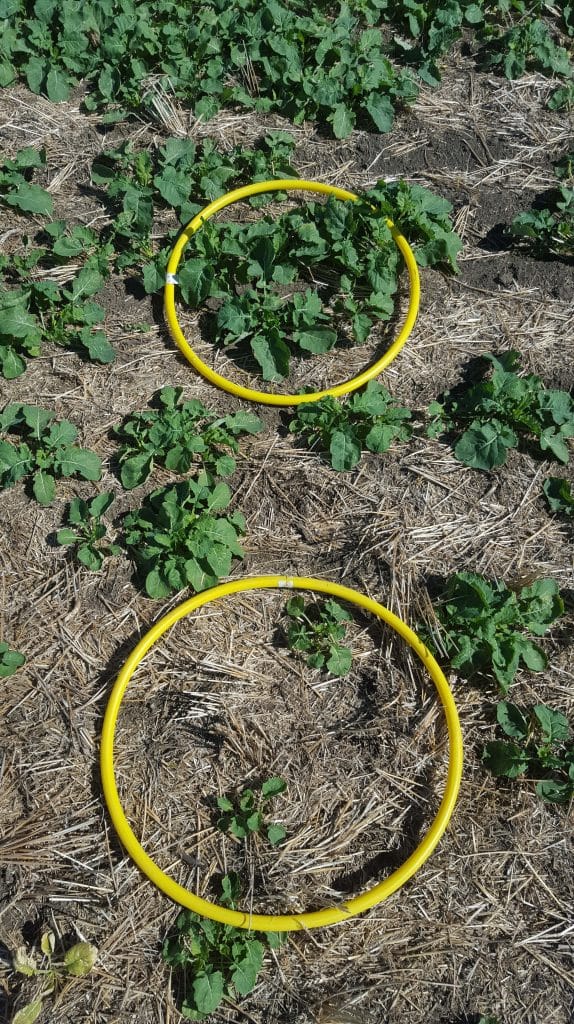
- Yield potential. Research shows that the critical level for plant populations is somewhere between 30 and 40 plants per square metre 1, 2. Stands below 30-40 plants per square metre do not tend to reach their full yield potential 3 but reseeding this stand will not necessary improve profit potential because seeding late tends to produce lower yields 4, 5, 6, 7 and may not mature before a fall frost.
- Insect pressure. Insect feeding can have a more dramatic impact on yield potential when plant densities are low because the insect population is spread over fewer plants. At low plant densities, it takes fewer plants lost or damaged to have a more dramatic impact on yield. Therefore, the lower the plant density, the fewer insects needed to reach the action threshold for control 8. For this reason, crops with low plant densities will need more frequent and intensive scouting for insects at all plant growth stages.
- Weed pressure. Since canola is not a fierce competitor until it covers ground, weeds can dramatically reduce yields due to competition with the crop for light, moisture and nutrients. This weed competition reduces canola plant growth and leaf area resulting in increased flower, pod and seed abortion. Depending on weed type, density and stage of development, weeds can reduce canola yields between five percent to over 50% 9.
Weed management is essential to preserve the yield potential of a thin stand. A thin stand takes longer to fully cover the ground, giving weeds more room to grow and compete. Sequential applications of system herbicides may be required until full canopy closure is achieved. - Fewer plants mean bigger, later plants. At recommended plant densities, canola plants normally produce three to five secondary branches, not including the main stem. At low densities of 20 to 30 plants per square metre (two to three plants per square foot), canola plants will branch up to four times more than those within plant stands of 70 to 140 plant per square metre. This extra branching can delay seed maturity up to 21 days depending on environmental conditions 10.
Extra branching also requires careful harvest management. Swathing when seed color change is at 60% on the main stem will reduce quality concerns and improve yield potential on areas with marginal increases in secondary branches (two times the normal). If there is a substantial increase in secondary branches (three to four times the normal), the main stems will represent a smaller proportion of total yield, so it will be more important to evaluate the whole plant to determine maturity. Look for an average of 30% to 40% seed color change total for the whole plant. In this case, the main stem may have seed color change well above 60%. With normal stands (50 or greater plants per square meter), the main stem and the primary branches are the major contributors to yield. But as populations thin, the main stem becomes a minor contributor and the majority of seed will be on the primary and secondary branches. Make sure as much of the immature seed in the side branches as possible is at least firm and dark green to help reduce yield and quality losses.
To diagnostic considerations when scouting for missing plants and ongoing threats, see this Canola Watch article.
Is reseeding necessary?
Each year fields or portions of fields suffer from poor emergence or from damage after emergence by frost, hail or insects. The crucial question to answer is whether reseeding will result in greater net profitability without significantly increasing risk? To aid in this decision, carefully consider the cause and severity of the damage, the percentage of the field affected, soil moisture, weed competition (amount, stage and type), reseeding costs and calendar date.
An accurate assessment of crop injury is essential. Take the time necessary to assess plant survival. Damage may not be as bad as it seems at first. Yield potential of the crop may also be better that you think. Canola seedlings damaged by frost, wind or hail need several days to recover before accurate assessments of survival can be made. Severe damage to cotyledons and true leaves that cause yellowing, browning or blackening of outer leaf tissue does not mean that seedlings are dead.
If the growing points and hypocotyls (the stem from the seed to the above-ground growing point) remain intact and turgid, those plants should survive. Recommendations are to re-assess those plants four to 10 days after the damage has occurred. At this time, small leaves will begin to emerge from the growing points, indicating that the plants will survive. If no new leaves emerge, survival is unlikely.
With successive nights of frost, the recovery period may be one week or more from the initial injury before new leaves begin to be noticeable. Seedlings that have been mortally injured will have either darkening of the growing point itself or pinching and browning of the stem below the growing point. In some cases, only the top of the stem is pinched causing the top to lean. Look for new growth out of the growing point several days after the last damaging event. In other cases, the whole stem withers and the seedling collapses on the ground. If that occurs, the plant is likely dead.
Even if many plants have been killed, reseeding may not be the best response. During early growth, most canola stands can sustain substantial seedling mortality without significantly affecting yield due to compensatory branching of surviving plants. Make random plant density counts from the damaged field. The larger the area of damage, the more counts should be made.
Ensure the majority of the field contains the minimum plant number that can produce an acceptable yield. If not, then reseeding part of the field or the whole field may be the best economical response.
As a reasonable guideline, plant densities of 20 to 40 plants per square metre (two to four plants per square foot) can be adequate to produce a viable crop, provided weed competition can be effectively controlled.
Thin stands such as these probably will yield 90% of a normal stand seeded at an early date, and could mature later. This is still an advantage over crops replanted late in the season, which typically yield less than earlier plantings that have poor stands. Although some reseeded crops manage to yield the same as very thin crops (which haven’t been reseeded), they incur more costs due to reseeding and, therefore, result in lower net returns.
Footnotes
- Harker, N.K. and Hartman, M.D. 2017. Nitrogen and seeding rate versus novel inputs for Western Canada canola production. Canadian Journal of Plant Science. 97:32-43. DOI.org/10.1139/cjps-2016-0138.[↩]
- Kutcher, H.R., Turkington, T. K., Clayton, G. W., Harker, K. N. 2013. Response of herbicide-tolerant canola (Brassica napusAlso referred to as Argentine canola, it is the species of canola currently commonly grown in Canada. More L.) cultivarsCultivars are variants in a species developed through the intervention of humans (despite the term 'variety' often being incorrectly used to describe this). Cultivars can be open-pollinated type, hybrid, synthetic, composite, etc. More to four row spacings and three seeding rates in a no-tillA type of tillage management technique where soil is undisturbed from harvest through planting, seeding with narrow knives/hoes or discs. More production system. Canadian Journal of Plant Science. 93:1229-1236. DOI.org/10.4141/cjps2013-173[↩]
- Shirtliffe, S. 2009. Determining the economic plant density in canola. CARP project 2006-08. Available on the Saskatchewan Canola Development Commission (SaskCanola) website[↩]
- 2010 – 2019: Seeding Date vs. Average Yield Response. 2020. Manitoba Agricultural Services Corporation (Manitoba Management Plus Program). Available online.[↩]
- Alberta crop insurance data for 2001-10. Agriculture Financial Services Corporation.[↩]
- Kondra, Z.P. 1977. Effects of planted date on rapeseed. Can. J. Plant Sci. 57: 607-609.[↩]
- Kirkland, K.J. and Johnson, E.N. 2000. Alternative seeding dates (fall and April) affect Brassica napusAlso referred to as Argentine canola, it is the species of canola currently commonly grown in Canada. More canola yield and quality. Canadian Journal of Plant Science. 80 (4): 713-719.[↩]
- Canola Council of Canada. 2002. Canopy Manipulation Trial. Yorkton, Saskatchewan[↩]
- O’Donovan, J. Agriculture and Agri-Food CanadaAgriculture and Agri-Food Canada is a department of the Government of Canada. More. Personal communication[↩]
- Canola Council of Canada Canopy Manipulation Trial[↩]
